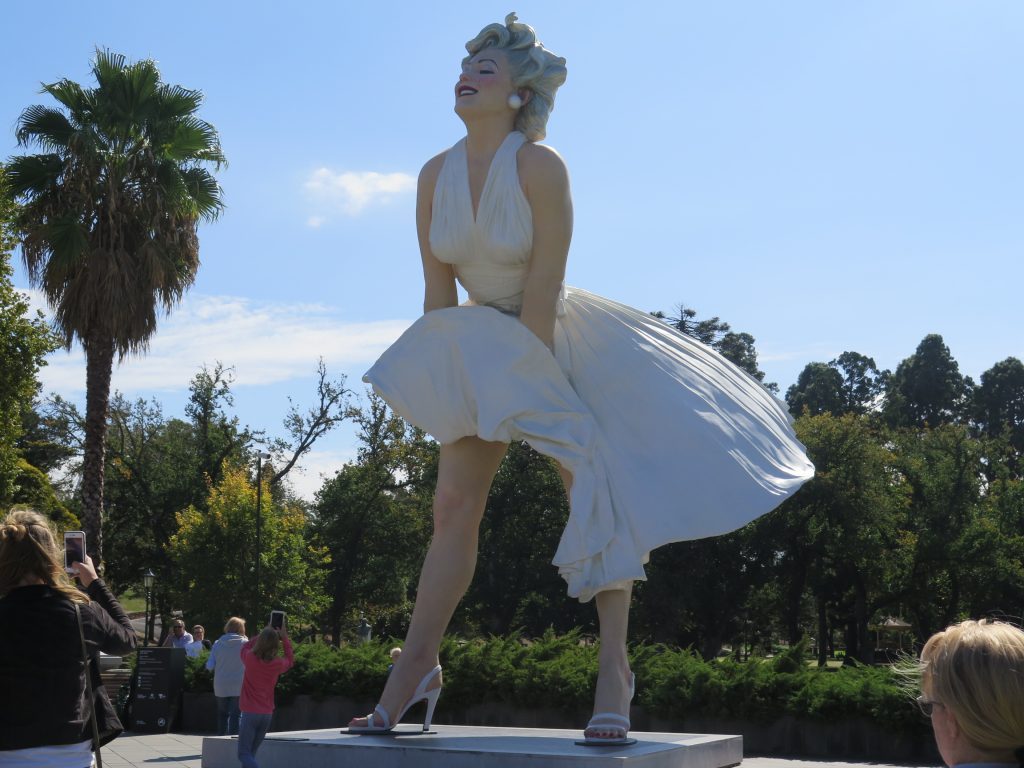The fabulous 1930s Hotel Victoria with murals in Avoca
29 March 2o16
Today we again have a long drive to our destination of Bright, so we decided to get an early start, and have breakfast along the way, but first taking a few photos of Halls Gap in the early morning sunshine (right). Then we drove back to Stawell then took the road east to Ararat then turned on to the Pyrenees Highway until we arrived at the quaint little town of Avoca.
Avoca is a former gold mining town on the banks of the Avoca River, the Avoca region is home to an established agricultural and winery industry thanks to its Mediterranean climate, good soil and running streams. The Pyrenees Pie Shop (left) made us a cheese and tomato toastie and a warm croissant with coffee before we continued on our way!
Avoca abounds with history, wine, stunning scenery and nature The wide main street is a delight to explore with hotels, cafes, local craft and gift shops and galleries all housed in historic buildings dating back to the 1850s. Avoca is the heart of the Pyrenees Wine Region, renowned for its premium Shiraz and Cabernet Sauvigon and increasingly its fine range of wonderful sparkling wines. There are more than 20 cellar doors to explore in the Pyrenees Wine Region.
The unusual and striking war memorial in Avoca (left) and the Avoca Hotel (right)
The next towns we drove through were Maryborough and Castlemaine, then on to Bendigo where we had a break and a walk around this beautiful old city.
Many of Victoria’s cities and towns owe their origins to the gold rushes of the 19th century and Bendigo is one of them. Gold was no temporary lure to this city located right in the centre of Victoria – its attractions were more than just skin deep. In fact there was very little gold on the surface at all. Most of it was far underground in rich quartz reefs stretching out over 3,600 hectares around the city.
The colourful display, and Conservatory, in Rosalind Gardens
The gold rush began in 1851 when the first diggers rushed to the Bendigo fields and continued until 1954 when the last winch on the city’s last gold mine raised its last bucket of ore. In recent years mining for gold has re-commenced deep under Bendigo and continues today. During the city’s first golden century, Bendigo became a melting pot with its own unique ethnic character – the Irish at St Killians, the Cornish at Long Gully and the Germans at Ironbark Gully. These groups were just some of the many communities that helped to build Bendigo.
German architects W C Vahland and Robert Getzschmann, along with Bendigo born William Beebe, were responsible for many of the city’s finest buildings. One of the most enduring and distinctive contributions was made by the Chinese. Bendigo’s Chinese heritage is well represented to this day, with the Historic Joss House and the Golden Dragon Museum and Classical Chinese Gardens.
The influence of the gold rush can be felt in the very fabric of the city. Bendigo owes its broad and regular boulevards to the ambitious town plan prepared in 1854. Other streets follow the paths beaten by fossickers as they followed gullies and leads in search of gold. The city’s ostentatious public buildings and gardens attest to the flamboyance of the gold rush era. So do the richly decorated privates homes.
Alexandra Fountain is regarded as one of Bendigo’s most prominent landmarks and monuments. The fountain is located in Bendigo’s “Charing Cross”, the intersection of View Street and Pall Mall.
I’m sure the most photographed statue in the city is the three-storey statue of Marilyn Monroe (below) that has arrived from the United States as part of an exhibition about the actress. The eight-metre tall resemblance, weighing 15 tonnes, will promote an exhibition about the screen legend at the Bendigo Art Gallery which opened in March. The sculpture, Forever Marilyn, is by American artist Seward Johnson and takes its inspiration from the 1955 film, The Seven Year Itch, in which Monroe’s character stands over the subway grates with her dress billowing up around her. I thought she was gorgeous and I was fascinated at how many people stood underneath the statue, gazing upwards at her panties – I did too and yes, they are white with lace around the edges!
You can read about the exhibition and see a video of the construction of the statue here
I loved the historic buildings (below), and had a walk, on what was a beautiful sunny and warm day, through the picturesque Rosalind Gardens on the edge of the main CBD (left).
After criss crossing a few highways and byways we were back on the Hume Highway and heading for Myrtleford, and finally Bright where a friend lives – a friend I used to work with in the barristers’ chambers and Supreme Court in Phillip Street Sydney in the 1970s! It had been raining lightly, but that didn’t stop us going out to one of the local restaurants for a delicious dinner, with time for a long chat about “old times”.
Tomorrow we are heading for Tallangatta, near Albury and the border of NSW to stay with another long-time friend.













